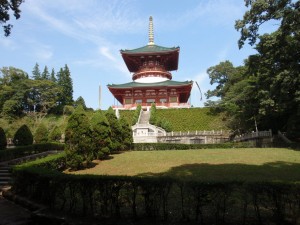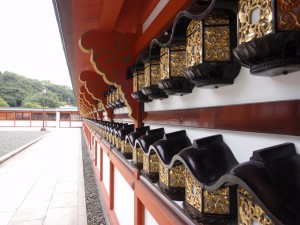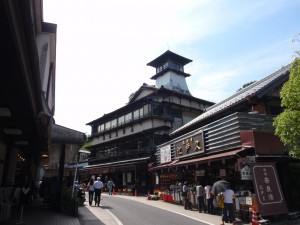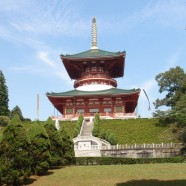Day Tripping In Narita
Narita, Japan, proves to be much more than a layover spot for Pride Travel owner and CEO Marc Kassouf.

The Daito Pagoda towers majestically behind the main tier of Narita’s Shinjoji temple. (c) PRIDE Travel / S. Nathan DePetris
Flights heading to the U.S. out of Tokyo’s Narita International Airport depart during all hours of the day and evening, and tour operators tend to offer travelers ample free time at or around Narita airport, without any scheduled sightseeing activities. For some clients, this might seem like a waste of time — but it doesn’t have to be. Travel professionals can use this extra time to build an authentic experience for their clients, and to discover an amazing local treasure: Narita City and the Narita-san Shinjoji Temple.
What to Do
For an “airport town,” Narita City offers a number of meandering streets to uncover, with plenty of local restaurants, shops and parks to enjoy. In fact, many visitors might be surprised to find out that Narita City possesses a historic, centuries-old heritage that was present long before the airport was ever built. A day trip or an overnight stay in Narita will be a pleasant surprise to travelers flying in or out of the Narita airport.
When planning a visit to Tokyo through Narita, agents should plan on giving clients one or two extra nights to allow them to explore the local Japanese culture in the small communities that surround Narita and the Chiba prefecture. Your clients will surely thank you for it.
Narita-san Shinjoji Temple is the town’s crown jewel. Worshipers travel from all over the region to this cultural heritage temple during Buddhist holidays. One can easily spend half a day walking the temple grounds alone, exploring its beautiful winding paths, ponds and pagodas.
To enter the temple, you walk through a traditional Buddhist gate surrounded by nearby stalls that bear curious talismans. Markers dot the hillside to commemorate those who have contributed to the temple’s well-being.

When visiting Naritasan Shinjoji temple, exquisite attention to detail is evident from any angle. (c) PRIDE Travel / S. Nathan DePetris
Once you reach the top of the hill, the grounds open up immensely, and a large incense burner, located directly in front of the landing, douses the air with its heavy, yet cleansing smoke. Behind it, the pavilion building acts as the temple’s main worship and meditation hall. To the right of the main hall lies the Sanjunoto, a three-tiered pagoda, one of the most intricately painted structures I have ever seen.
Near the Sanjunoto, there are several benches are available for resting or meditation. If time allows, clients should take the hike up behind the main tier of the pagoda where they will discover small creeks that meander through dense foliage and converge at a lake. Clients should follow the shoreline, tracing a path that heads back into the woods, past a smaller temple, to finish the circuit.
Where to Eat
Restaurants and shops dot Omotesando, the main street that bisects Narita City and connects the Narita-san Shinjoji Temple and the JR train station, curving into an “S” around the hill. Cuisine ranges from traditional to westernized Japanese food. Clients can also purchase homemade Senbei rice crackers and Yokan sweet-bean jellies in more flavors than they can count; most of these foodstuffs are unique to one store or just a few. If clients taste something they like, it is best that they buy some on the spot.
Near the Omotesando, clients will also find the modest-looking Onoya Ryokan, restaurant and shop. The specialty of the house is a five-flavored soba noodle combination dish, featuring regional cold soba noodles made with various ingredients such as spinach, beets or squash. To mollify any sweet tooth, clients should consider concluding their meals with matcha (green tea) ice cream, which is readily available in many stores and restaurants.

Onoya ryokan and restaurant towers above Omote Sando street, Narita, Japan. (c) PRIDE Travel / S. Nathan DePetris
Where to Stay
In Narita and its surrounding towns, ryokans (traditional Japanese inns) offer traditional Japanese accommodations with board for very reasonable prices. Nearby international-style airport hotels also offer excellent world-class accommodations and can be readily booked through hotel wholesalers such as Travel Bound, CCRA or your preferred partner suppliers.
How to Get Around
Taxi cabs can be rather expensive. A short ride, for example, from the Hilton Tokyo Narita Airport hotel to Narita City, might cost more than $120 each way.
A local community bus, the Narita City Round Bus travels from Narita International Airport to Narita City and other points of interest. An adult fare is approximately $2 each way; an adult day pass costs approximately $5.
Be sure to explain to clients that the trips to and from the airport on the bus are of different lengths of time because the system runs in a wide circle. Trips to the airport from Narita-san Shinjoji Temple take about 25 minutes, whereas trips from the closer Aeon Mall take more than an hour to complete since the bus must complete a full circle before returning to the airport. Agents should also include details about the scheduled bus departure frequency. More logistical information, bus schedules, maps and details can be found online at the following Chiba Prefecture informational websites: www.city.narita.chiba.jP/english and www.chiba-tour.jp/narita.
So, whether your clients only have a few hours or one or two days to spare during their next trip to Japan, it is well worth the time and effort to step outside the Narita airport doors and into Narita City.
Travel Insider
Marc Kassouf is owner and CEO of Pride Travel, specialists in catering to the needs of gay and lesbian clientele. Kassouf holds numerous industry certifications, most notably by CLIA, the Travel Institute and various destination visitors’ bureaus. He sits on two board committees of the International Gay and Lesbian Travel Association, has traveled to almost four dozen countries and has sailed on more than 60 cruises.
First Published: TravelAge West magazine, November 15, 2010








 Editor Marc Kassouf owns Pride Travel agency. He holds numerous travel industry certifications and has received one of the travel industry’s most prestigious awards, the WAVE TrendSetter, four times; the TrendSetter recognizes excellence and exceptional achievements of travel agencies and their executives. Kassouf sat on two board committees of the International Gay and Lesbian Travel Association, has traveled to nearly four dozen countries and has sailed on more than 60 cruises.
Editor Marc Kassouf owns Pride Travel agency. He holds numerous travel industry certifications and has received one of the travel industry’s most prestigious awards, the WAVE TrendSetter, four times; the TrendSetter recognizes excellence and exceptional achievements of travel agencies and their executives. Kassouf sat on two board committees of the International Gay and Lesbian Travel Association, has traveled to nearly four dozen countries and has sailed on more than 60 cruises.






